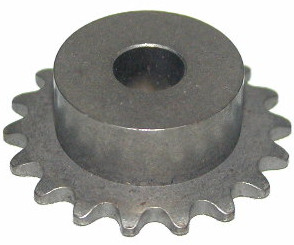I read boosts previous posts on this problem in another thread too with interest. I have a couple of questions now.
What does the 9.33 relate to?
planetary gearbox reduction With your formula If I swap out the 14 for a 13. I get down to 102 (3250/(9.33 x (44/13) So a 60 tooth front with a 13 front would give 75 rpm. A very comfortable cadence.
Yes the 14T>13T mod will also help. Whether it's cost is worth it in addition to a larger chainring is up to you. Am I trying to get to this in top gear at full throttle or is 3/4 better...
The standard Cyclone throttle is setup as a speed controller (like most) rather than a IMHO more intuitive current controller (possible to convert the signal from speed>current control using a Cycle Analyst >=2.11, Well worth it :wink . They also suffer from poor low speed control [Which is rectified with some aditional resistors spliced into the cable] http://www.endless-sphere.com/forums/viewtopic.php?f=2&t=12775
. They also suffer from poor low speed control [Which is rectified with some aditional resistors spliced into the cable] http://www.endless-sphere.com/forums/viewtopic.php?f=2&t=12775
Anyway, point is a certain throttle position will equate to the steady state speed of your best compromise RPM once acceleration/deceleration is complete. A CA is really needed to find this throttle position. when you have found it and you get used to the 'feel' of your assisting pedal cadence that matches this, you be able to more consistantly optimise your efficiency. Of course there is an optimal point, but you are really just trying to stay near it rather than right on it all the time. The problem is that the standard 36>48V kit's gearing doesn't even allow you to get close.
Would it be better to achieve this in 5th of my 8 ring rear, and suffer loses in efficiency in the last 3 higher gears & use less throttle & more peddle power. :?
Not sure what you mean here How much extra amp draw & loss of motor efficiency is there running at say = (44/14) at a cadence of 80 to 85.
Depends on loading (gradient), battery voltage, how much power you're adding with your legs etc.Sorry for all the questions

I have the felling this is a "how long is a bit of string" series of questions on my part :lol: & the answer is going to be "too many variables for an ideal" kind of answer.
I'm also wondering why bother with the smaller front crank at all, I have not used it yet even on a 10 degree incline. :?
It's there in case you have motor troubles or run out of battery power - Easier to lug the weight up hills as you 'crawl' home.
I do know I need a cycle analyst of watts meter to help me get the best out this setup.
Yep.


